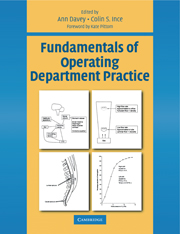Book contents
- Frontmatter
- Contents
- Contributors
- Preface
- Foreword
- Acknowledgements
- Introduction
- Chapter 1 The operating department practitioner, the patient and the law
- Chapter 2 Aspects of health and safety in the operating department
- Chapter 3 The caring practitioner
- Chapter 4 Strategies for infection control in the operating department
- Chapter 5 Sterilization, decontamination and the surgical field
- Chapter 6 The fundamentals of cardiovascular physiology
- Chapter 7 Fundamentals of respiratory physiology
- Chapter 8 Scientific principles in relation to the anaesthetic machine
- Chapter 9 Fundamentals of artificial ventilation of the lung
- Chapter 10 Scientific principles in relation to monitoring equipment
- Chapter 11 Scientific principles in relation to endoscopic, laser and radiological equipment
- Chapter 12 Pharmacological principles of drug administration
- Chapter 13 The pharmacology of drugs used in general anaesthesia
- Chapter 14 The local anaesthetic drugs - does the ideal agent exist?
- Chapter 15 The safe positioning of patients for surgery
- Chapter 16 Principles involved in the management and use of equipment
- Chapter 17 Understanding suture materials
- Chapter 18 Fundamentals ofpaediatric surgery and anaesthesia
- Chapter 19 Fundamentals of hyperthermia and hypothermia
- Chapter 20 Fundamentals of fluid and electrolyte balance during surgery
- Chapter 21 The physiology of blood and its administration
- Chapter 22 Fundamentals of pain relief
- Chapter 23 Fundamentals of dressings and drains in relation to wound healing
- Chapter 24 The recovery of patients from anaesthesia and surgery
- Chapter 25 Fundamentals of emergency and obstetric anaesthesia
- Chapter 26 Identification and management of anaesthetic emergencies
- Chapter 27 The fundamentals of emergency resuscitation
- Appendixes
- Index
Chapter 23 - Fundamentals of dressings and drains in relation to wound healing
Published online by Cambridge University Press: 05 October 2015
- Frontmatter
- Contents
- Contributors
- Preface
- Foreword
- Acknowledgements
- Introduction
- Chapter 1 The operating department practitioner, the patient and the law
- Chapter 2 Aspects of health and safety in the operating department
- Chapter 3 The caring practitioner
- Chapter 4 Strategies for infection control in the operating department
- Chapter 5 Sterilization, decontamination and the surgical field
- Chapter 6 The fundamentals of cardiovascular physiology
- Chapter 7 Fundamentals of respiratory physiology
- Chapter 8 Scientific principles in relation to the anaesthetic machine
- Chapter 9 Fundamentals of artificial ventilation of the lung
- Chapter 10 Scientific principles in relation to monitoring equipment
- Chapter 11 Scientific principles in relation to endoscopic, laser and radiological equipment
- Chapter 12 Pharmacological principles of drug administration
- Chapter 13 The pharmacology of drugs used in general anaesthesia
- Chapter 14 The local anaesthetic drugs - does the ideal agent exist?
- Chapter 15 The safe positioning of patients for surgery
- Chapter 16 Principles involved in the management and use of equipment
- Chapter 17 Understanding suture materials
- Chapter 18 Fundamentals ofpaediatric surgery and anaesthesia
- Chapter 19 Fundamentals of hyperthermia and hypothermia
- Chapter 20 Fundamentals of fluid and electrolyte balance during surgery
- Chapter 21 The physiology of blood and its administration
- Chapter 22 Fundamentals of pain relief
- Chapter 23 Fundamentals of dressings and drains in relation to wound healing
- Chapter 24 The recovery of patients from anaesthesia and surgery
- Chapter 25 Fundamentals of emergency and obstetric anaesthesia
- Chapter 26 Identification and management of anaesthetic emergencies
- Chapter 27 The fundamentals of emergency resuscitation
- Appendixes
- Index
Summary
INTRODUCTION
The process of wound healing plays a vital part in the ability of the patient to maintain homeostasis and recover from surgery. An understanding of the principles of wound healing has direct relevance to the choice and use of both dressings and drains. The principles outlined in this chapter apply equally to surgical incisions and minimally invasive techniques, such as cannulation. Essentially, injury may be caused by trauma, outside agents or deliberately, as in surgical incision or puncturing the skin during cannulation.
WHAT IS WOUND HEALING?
Healing is an automatic, self-regulating, natural process that has enabled man to survive disease and trauma. Throughout the ages there have always been healers who through magic, mystery or medicine have sought to speed up this process but generally it is true to say that man healed in spite of them. However, the growth of modern scientific knowledge and technological development within the last 200 years has brought us a health environment in which few wounds are beyond repair and in which most heal quickly and completely.
Healing can be defined as the restoration of the structure and function of diseased or damaged tissues. This process begins as soon as the injury occurs. The body's tissues vary tremendously in their constitution and this variation, together with the type and severity of the wound, is reflected in the way in which that tissue will heal. Thus superficial wounds will regenerate readily and quickly whereas wounds affecting the deeper layers of connective tissue will take longer to repair. Damage to bone, which contains large amounts of inorganic calcium, will heal at an even slower rate.
THE PHYSIOLOGY OF WOUND HEALING
Wounds can be divided into two main types:
1. Closed wounds where no overt tissue loss occurs.
2. Open wounds where there is tissue loss due to excision, trauma, burns or necrosis.
Where there is tissue loss its replacement may be achieved in two ways. First, there may be regeneration of identical tissues from undamaged cells in the area, thus replicating both structure and function. Second, where no undamaged cells remain, repair is achieved with granulation tissue. Granulation tissue is of a fibrous inelastic nature and fills in the defect adequately; it restores neither structure nor function but eventually leaves a raised and uneven scar.
- Type
- Chapter
- Information
- Fundamentals of Operating Department Practice , pp. 259 - 266Publisher: Cambridge University PressPrint publication year: 1999

